1. Introduction
 The Lightscribe strikes back, with the release of the HP 840i Super Multi DVD Writer. The 840i (or 840b as it was recognized by our computers, probably a region identifier), is not only a Lightscribe enabled drive, but also a DVD-RAM reader and writer among other things. It is capable of all high speed writing such as 16X DVD±R and 8X/6X for DVD+RW and -RW media respectively. Last but not least, the drive offers 8X burning speed for DVD+R DL and 4X for DVD-R DL media.
The Lightscribe strikes back, with the release of the HP 840i Super Multi DVD Writer. The 840i (or 840b as it was recognized by our computers, probably a region identifier), is not only a Lightscribe enabled drive, but also a DVD-RAM reader and writer among other things. It is capable of all high speed writing such as 16X DVD±R and 8X/6X for DVD+RW and -RW media respectively. Last but not least, the drive offers 8X burning speed for DVD+R DL and 4X for DVD-R DL media.
Throughout these pages, we will see how this drive performs with all media formats, including DVD-RAM and Lightscribe media, the capabilities of which we will inspect thoroughly further on.
- Specifications
| Model |
HP840i |
| Write Speed |
DVD+R 16X (CAV) |
| DVD-R 16X (CAV) |
| DVD+RW 8X (ZCLV) |
| DVD-RW 6X (ZCLV) |
| DVD+R DL 8X (ZCLV) |
| DVD-R DL 4X (CLV) |
| DVD-RAM 5X (CAV) |
| CD-R 48X (CAV) |
| CD-RW 32X (ZCLV) |
| Read Speed |
DVD-ROM 16X (CAV) |
| CD-ROM 40X (CAV) |
| Sustained Transfer |
1x CD = 150KB/s (data mode 1); 1x DVD = 1350 KB/s |
| Burst Transfer rate |
33 MB/s max |
| Access time |
DVD-ROM (SL) 140ms |
| DVD-ROM (DL) 175ms |
| DVD-RAM 250ms |
| CD-ROM 160ms (typical) |
| Disc finalization time |
DVD<2 minutes at 4X (DVD+R SL) |
| CD<1 minute typical |
| Mean time between failures (MTBF) |
100.000 POH at 20% duty cycle in room temp |
| Operating temperature |
5° to 45° C (41° to 113° F) |
| Storage temperature |
-30° to 60° C (-22° to 140° F) |
| Operating humidity |
10%~80% RH (Non-condensing) |
| Storage humidity |
10%~90% RH (Non-condensing) |
| Power requirement |
+5V±5%; +12V±10% |
| Compatibility |
| Device write media compatibility |
CD-R, CD-RW, DVD+R, DVD+R DL, DVD+RW, DVD-R, DVD-R DL, DVD-RW, LightScribe CD-R, Lightscribe DVD+R, 4.7GB single-sided/ 9.4 GB double sided DVD-RAM (2.6 GB single-sided/5.2 GB double sided media not supported) |
| Device read media compatibility |
DVD-ROM, DVD+R, DVD+R DL, DVD+RW, DVD-R, DVD-R DL, DVD-RW, DVD-Video, 4.7GB single sided/9.4 GB double-sided media not supported), CD-R, CD-RW, CD-DA, CD Extra, CD-ROM (Mode 1 -Yellow Book), CD-ROM/XA & CD-I Ready (Mode 2/Form 2 -Green Book), Photo-CD (single and multi-session), VCD, CD-Text |
| Warranty |
1 year limited hardware and software warranty from date of purchase |
Below is the time needed for the drive to complete a SL disc with full label, divided into three quality types.

Unfortunately, being a Panasonic chipset based drive, it does not support region setting...
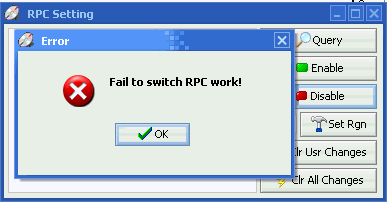
Below are the main specs for the drive as given by NeroInfoTool and DVDInfoPro:
- Nero InfoTool

- DVD InfoPro


- The Drive

The drive comes in a HP retail package with all the necessary tools and software to get the end user started.
The package contains
the Internal HP840i DVD±R/RW drive, one software CD including the user's guide, Quick start placemat, Getting help guide, mounting screws, software including Nero OEM suite (for DVD Authoring, writing, editing and backup), SureThing (for LightScribe labeling) and CyberLink PowerDVD (for DVD playback). There is an optional, additional feature, a LightScribe enabled media which can be purchased separately as the manufacturer states.
- Front panel view

- Rear panel view

- Label


Notice here the Model description. The drive is actually an LG OEM drive, the GSA-4166B more specifically. Hence the Panasonic chipset.
One more time, we will be taking a quick look under the hood, to investigate the drive's chipset and drive mechanism. Opening the case renders the guarantee void (1 year guarantee provided by HP) so we strongly advise against it. Clicking on the image below will open a larger image.
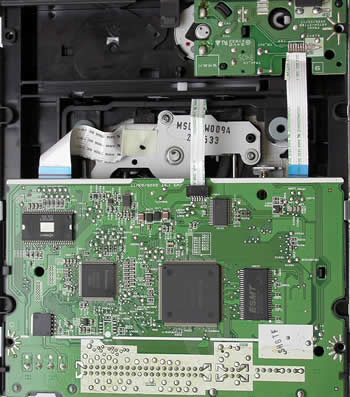
From the manufacturing label, we see that the drive is regulatory model GSA-4166B, an LG OEM drive, and uses the Panasonic chipset found in all LG drives.
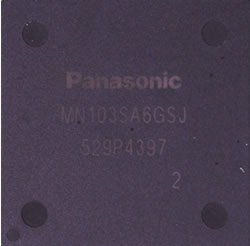
- Installation
The drive came to our labs with the latest firmware installed, version FF66, as seen in the screenshot below, taken from the Nero Properties page. The drive was identified as HP DVD Writer 840b under Windows XP.
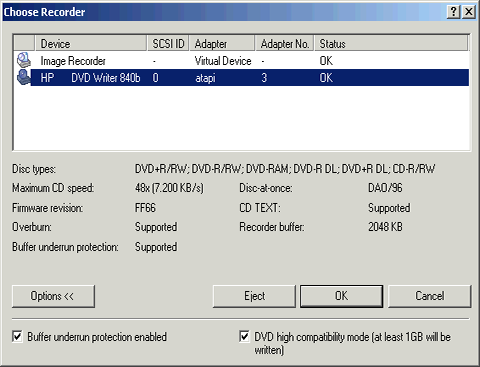
For this review, we will be posting the results of the HP840b along with the results of the LiteOn 1635s and the Plextor 740A, both latest technology drives. So let's move on to the next page where we investigate the HP drive's reading capabilities.
2. Reading Tests
- CD Format
 For our CD transfer rate tests, we used the Nero CD-Speed utility on Pressed and CDR media. Let's take a look at how the drive performed compared to the other drives in this comparison.
For our CD transfer rate tests, we used the Nero CD-Speed utility on Pressed and CDR media. Let's take a look at how the drive performed compared to the other drives in this comparison.
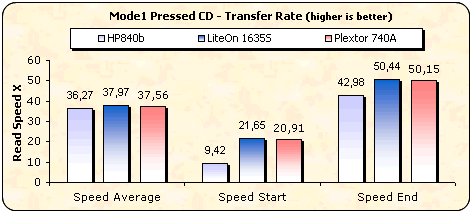
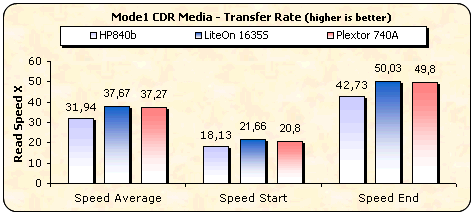
The LiteOn and Plextor drives both support up to 48X max reading speed for both pressed and CDR media while the HP drive supports up to 40X. It is therefore logical that the HP850b was the slowest reader of the three drives.
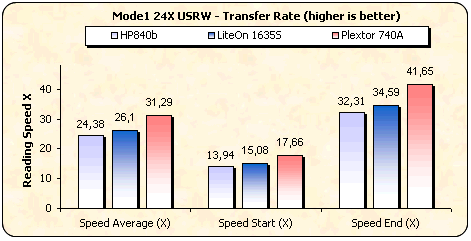
With USRW media, the HP840b was again the slowest reader with the Plextor drive way in front.
- AudioCD
For this tests we used a pressed AudioCD and its copy on CD-R media.

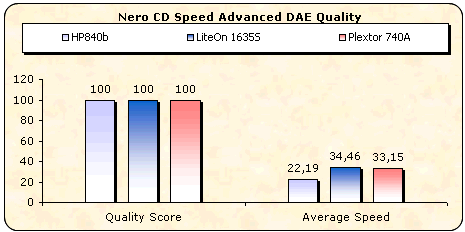
The HP840b supports a low DAE speed, reporting averages of 23,99X and 23,87X with pressed and CDR media respectively, while achieving a quality score of 100 points and an average speed of 22.19 as reported by the CDSpeed Advanced DAE test.
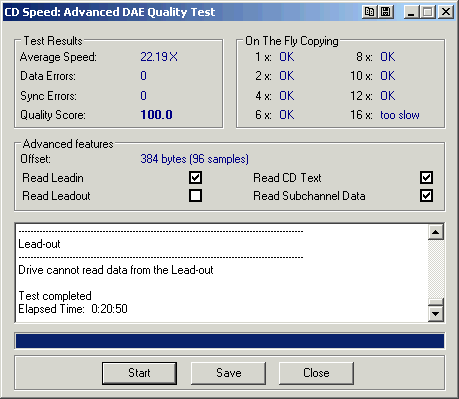
- 90mins Audio disc
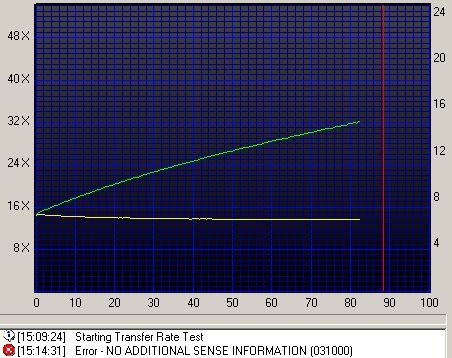
- 90mins Audio disc

Unfortunately, the drive could not finish the test while reading the 90min audio disc. On the other hand, the 840b achieved a perfect reading when reading the 99min audio disc.
- DVD Format
 Now let's have a look at how the drive performs with DVD media. Again, a set of DVD media was used, both SL and DL.
Now let's have a look at how the drive performs with DVD media. Again, a set of DVD media was used, both SL and DL.

The above reading confirmed the manufacturer's specifications. All drives performed at similar speeds.

The two layers of a PTP DVD-ROM disc are read sequentially
with the drive starting reading from the inner part of the disc, which is the
beginning of each layer, progressing towards its outer range.
The Plextor drive was fastest with a difference when reading the PTP DL media, supporting a maximum reading speed of 12X. The HP840b and the LiteOn 1635S had similar speeds.
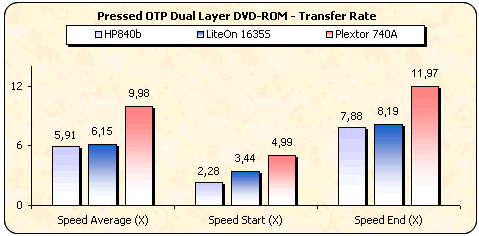
The first layer of an OTP dual layer DVD-ROM is read exactly
the same way as the first layer of the PTP disc we tested previously, the main difference being the reading strategy of the second layer on the disc. The beginning
of the second layer is located in the outer part of the disc, so the drive
starts reading from the outer tracks towards the inner part of the disc. Same performance again, this time with PTP media.

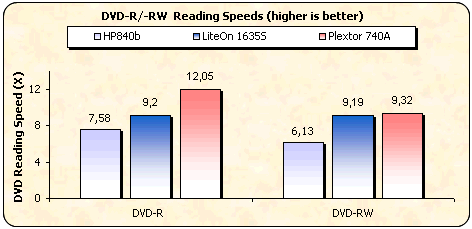
After performing the reading tests with -/+ R and RW media, we can see that the HP 840b is not the fastest DVD reader on the market, while it is not slow either. Once again, we see that the Plextor drive is the fastest reader.

Very few drives can stand up against the Plextor drive when it comes to DVD ripping. With an average speed of 8,785kB/s, the HP 840b drive gave good results, although obviously no match for the Plextor 740A.
- DVD-RAM

As mentioned before, the HP840b is a Super Multi drive, and as such, it can read DVD-RAM media at up to 5X reading speed.
-Appendix
Nero CD-DVD Speed Graphs
CD Pressed / CD-R / US-RW / AudioCD / AudioCD-R
DVD Pressed SL / DVD Pressed DL PTP / DVD Pressed DL OTP / DVD-R / DVD-RW / DVD+R / DVD+RW / DVD-RAM
3. CD Error Correction Tests
In the following tests we check the drive's behavior when reading
scratched / defective audio discs. The test discs used were the ABEX series
from ALMEDIO.
- ABEX TCD-721R


|
Errors
total
|
Num:
829339
|
|
Errors
(Loudness) dB(A)
|
Num: 49764 |
Avg:
-74.6 dB(A) |
Max:
-19.8 dB(A) |
|
Error
Muting Samples
|
Num: 2687 |
Avg:
1.1 Samples |
Max: 89 Samples |
|
Skips
Samples
|
Num: 0 |
Avg:
0.0 Samples |
Max:
0 Samples |
Total Test Result |
76.9 points (out of 100.0 maximum) |
The reported total errors is low as is the average loudness level. There were no skipped samples and in general the drive has a good CD-error correction mechanism.
- ABEX TCD-726

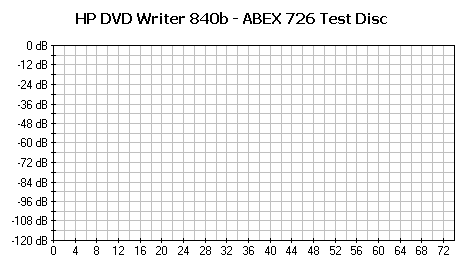
Errors total |
Num: 2036 |
Errors (Loudness) dB(A) |
Num: 3018 |
Avg:-174.0 dB(A) |
Max:-174.0 dB(A) |
Error Muting Samples |
Num: 0 |
Avg: 0 Samples |
Max: 0 Samples |
Skips Samples |
Num: 0 |
Avg: 0 Samples |
Max: 0 Samples |
Total Test Result |
100.0 points (out of 100.0 maximum) |
With the 726 test disc, the results were very good, with flawless reading and a perfect total test result score.
- CD-Check Audio Test Disc
 The CD-Check Test Disc is a very useful tool for evaluating the Sound Reproduction
/ Error correction capabilities of a CD player. The disc offers a signal combination
with disc error patterns to rate the drive's abilities to read music and reproduce
it completely. Five tracks on the disc contain a sequence of progressively
more difficult tests. These tracks are referred to as Check Level-1 through
Check Level-5.
The CD-Check Test Disc is a very useful tool for evaluating the Sound Reproduction
/ Error correction capabilities of a CD player. The disc offers a signal combination
with disc error patterns to rate the drive's abilities to read music and reproduce
it completely. Five tracks on the disc contain a sequence of progressively
more difficult tests. These tracks are referred to as Check Level-1 through
Check Level-5.
The
tracks are reproduced through a software multimedia player (e.g.
Windows Media Player). Each level is considered as passed, if the tone
is smooth, continuous without interruptions, skipping or looping. The higher
the Check Level passed, the more reliable the sound reproduction
of the tested drive.
|
Error Level
|
1
|
2
|
3
|
4
|
5
|
|
|
5/5
|
5/5
|
5/5
|
5/5
|
0/5
|
With this test disc, the drive reported very good results, achieving flawless reading in 4 out of 5 tracks. This is better than average performance.
- Summary
In general, a very convincing performance with all the test discs, in most cases better than average performance. With the CD-Check Audio test disc, the results were more than satisfying, as the drive managed to playback 4 out of 5 tracks, which is considered very good performance.
4. DVD Error Correction Tests
In the following tests, we check the DVD reading capabilities of the HP 840b drive with scratched / defective DVD media. For our tests, we used CDVD Benchmark and Nero CDSpeed . The reference test media comes from ALMEDIO.
- Single Layer media
ABEX TDR-821
This is a single sided, single layer DVD-ROM with a 4.7GB capacity, and its surface has an artificial scratch varying in dimensions from 0.4 to 3.0 mm.

The following transfer rate picture comes from the CDVD Benchmark v1.21 transfer rate test.

Very smooth reading, with no drops in speed although the drive did not reach 16X max reading speed, which is the maximum supported speed with SL media, since the test media is a DVD-Video disc.
ABEX TDR-825
This is also a single sided, single layer DVD-ROM of 4.7GB capacity. The data structure of the disc is exactly the same as that of the TDR-821, the only difference being that there are no scratches on it. Instead, there are defective areas, ranging in dimensions from 0.5 to 1.1 mm.

There are also fingerprints sized between 65 and 75 micrometers.
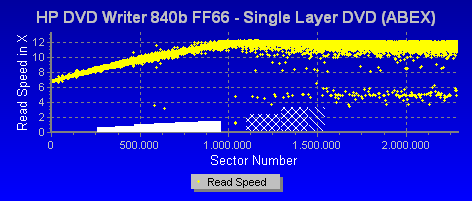
In this case, the drive seems to have had a few problems from about the second defect onwards. Once more, only 12X max reading speed was achieved.
- Dual Layer media
ABEX TDR-841
This is an 8.5GB dual layer single sided DVD-ROM disc with artificial scratches ranging in dimension from 0.4 to 3.0mm, on both layers.


Both layers were read succesfully, without any drops in speed. Excellent performance with this type of media from the HP-840b drive.
ABEX TDR-845
The disc is a single sided, dual layer DVD-ROM disc of a 8.5GBcapacity. The only difference between the TDR-845 and the TDR-841 is that the former includes defective areas and fingerprints.

The dimensions of the defective areas range from 0.5 to 1.1 mm and the fingerprints are sized from 65 to 75 micro meters.

Again, no errors were reported, while the reading was smooth over both layers.
ABEX TDV-541
The TDV-541 is a single sided, dual layer DVD-VIDEO disc, with a capacity
of 8.5GB. The disc is based on the TDV-540 series which was designed to inspect and adjust DVD-VIDEO players. The disc checks the layer switch operation
from layer 0 to layer 1 and also includes test pictures and test signals on
DVD sound files.

The current TDV-541 also checks the error correcting capabilities of
the drive. It also includes scratches from 0.4 to 3.0 mm.
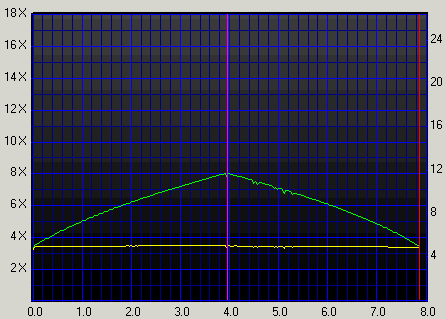
Very good error correction capabilities, smooth graph all the way to the end of the test.
ABEX TDV-545
The TDV-545 disc is based on the TDV-540 series. It is a single sided, dual layer DVD-VIDEO disc with a capacity of 8.5GB. The TDV-545 includes artificial black dots on the data surface, sized from 0.4 to 1.0 mm. It has also 65 - 75 micro meter fingerprints.

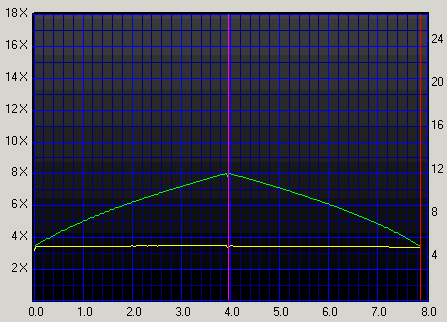
Same performance as with the previous media. The 545 test media was no match for the drive's error correction mechanism.
- Summary
Overall very good DV
D error correction mechanism. All tests were completed without errors. The only drawback wsa that the drive never managed to achieve 16X max reading speed.
5. Protected Disc Tests
On this page, we will check the drive's ability to read and backup protected CDs.
- AudioCD protections
 For the test procedure we used three audio discs with different audio copy protections. The ripping process on all protected audio discs was carried out with Exact Audio Copy v0.9 beta5.
For the test procedure we used three audio discs with different audio copy protections. The ripping process on all protected audio discs was carried out with Exact Audio Copy v0.9 beta5.
The protected audio discs tested, were:
| Audio Discs |
Protection |
| Celine Dion - New Day Has Come |
Sony's Key2Audio |
| Natalie Imbruglia - White Lilies Island |
Cactus Data Shield 200 |
| Aiko Katsukino - The Love Letter |
Cactus Data Shield 200.0.4 - 3.0 build 16a |
The Cactus Data Shield 200, contains artificial errors that are not easily bypassed by the reader, while the Key2Audio contains a second session causing problems for readers when trying to read the Table Of Contents (TOC).
The test procedures are:
- Recognition of the inserted disc (Yes/No).
- Ripping all wav files (with EAC's Burst Mode) to the hard disk through copy&compare function.
- Listening to the produced wav files to detect any possible clicks/skips.
The drive recognized up to the 12th Audio track in the CDS200 disc,

and with the "Retrieve Native TOC" option removed, the drive recognized the 13th track.

The ripping test results are shown in the following table:
|
Key2Audio |
CDS200 |
HP 840b |
The drive could not rip the specific media. |
Ripping process completed, EAC reports no problems, Read&Test CRC comparison successful for all tracks |
Unfortunately, the Key2Audio disk could not be read by the drive. On the other hand, the CDS2000 was ripped successfully.
- Cactus Data Shield 200.0.4 - 3.0 build 16a (Aiko Katsukino - The Love Letter)
This is a "special" CDS200 build, since it doesn't contain any artificial errors which create problems during the ripping process. Most problems occur when trying to write the ripped wav files, since the produced CD-R disc contains C2 and CU errors! This "problem" is rumored to be connected to specific chipset weaknesses.
|
CDS 200.0.4 - 3.0 build 16a |
HP 840b |
Reading performed without any errors. |
- Games Protections
 To create an image of the various protected titles onto the hard disk, we used Alcohol 120% and the appropriate settings, according to the protection type of the inserted discs. Below you can see the duration of each process as well as the transfer rate in each case.
To create an image of the various protected titles onto the hard disk, we used Alcohol 120% and the appropriate settings, according to the protection type of the inserted discs. Below you can see the duration of each process as well as the transfer rate in each case.

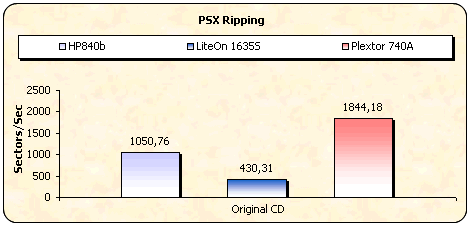
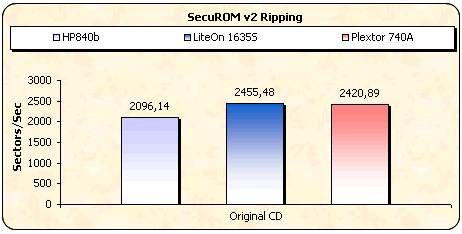
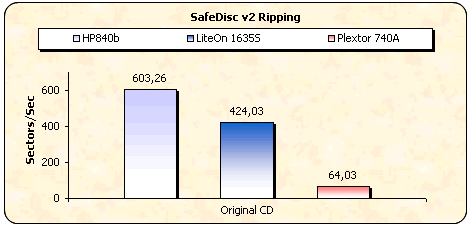
All three games were ripped successfully and at high speeds by the HP-840b drive.
- Writing Tests
The HP-840b supports the DAO-RAW writing mode. To check the drive's
EFM correction status we used 5 different game titles with different SafeDisc
2 versions, having the latest software patches installed. After making the images
of the various titles onto the hard disk, we burned them (at maximum speed) with
Alcohol 120% v1.9.2.3105. Two different discs were recorded for each title;
one with the "Rectify Sub-Channel Data" enabled and one with the function
disabled.
- Fifa 2004 - Safe Disc v3.1x
- The Sims Superstar - Safe Disc v2.9x
- The Sims Unleashed - Safe Disc v2.8x
The drive managed to create a working backup of SD v3.1, something that not many drives can do.
6. CD Recording Tests
- CD-R Format
The drive supports 8X, 16X, 24X, 32X, 40X and 48X (CAV) writing speeds.
According to Nero CDSpeed, the reported average speed when recording at 40X
is 30.38X.
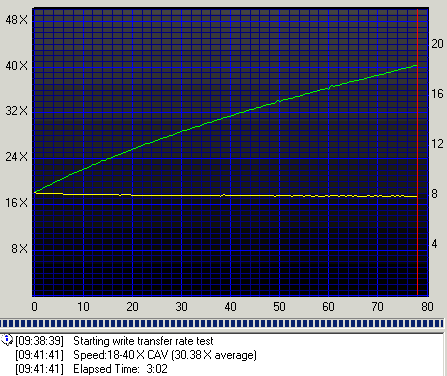
Note here that according to the manufacturer's specifications, the drive supports up to 48X writing speed for CD-R media. In our tests we managed to achieve a maximum of 40X with all inserted media as we will see further on.
- CD-R Recording Times
We created an 80min data compilation with Nero Burning Rom and recorded
it on a 700MB disc. The writing performance varies according to the inserted
media. Below is a chart depicting all recording times with
various media.
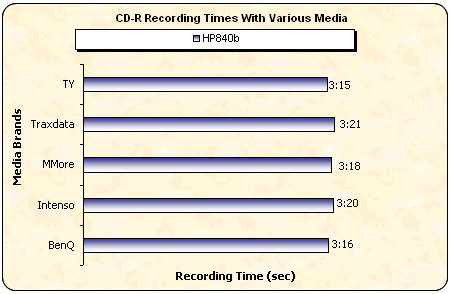
As we see in the above graph, fastest burn came with TY media, burned at 40X in 3:15. Several media were burned but unfortunately none of them achieved the max writing speed of 48X.
- Other features
Overburning writing |
Up to 99min |
CD text reading/writing |
Yes |

The drive supports CD Overburning up to 99mins.
- CD-RW Format
The drive supports 4X, 10X, 16X (CLV), 24X (Z-CLV) and 32X (Z-CLV) rewriting speeds,
with Ultra Speed Rewritable Media
(US-RW).
Below you can see the Nero CD-DVD Speed writing simulation test with blank 24x US-RW media. We also tried writing with 32X RW media and once more, the drive did not confirm the manufacturer's specs, burning at a maximum of 24X (Z-CLV).

The drive, when recording at 24X , reported an average writing speed at 22.38X.
7. CD Writing Quality - Plextools
Untitled Document
 We measured the C1 / C2 error rate on the recorded discs we burned at the
various supported writing speeds. The software we used is the latest PleXTools Professional and in particular the built-in Q-Check utility. The Plextor PX-716A was the reader.
We measured the C1 / C2 error rate on the recorded discs we burned at the
various supported writing speeds. The software we used is the latest PleXTools Professional and in particular the built-in Q-Check utility. The Plextor PX-716A was the reader.
BenQ 80min 52X @ 40X

Intenso 80min 52X @ 40X
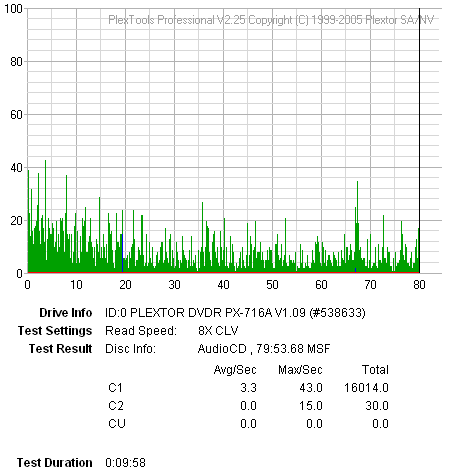
MMore 80min 52X @ 40X

Traxdata 80min 52X @ 40X
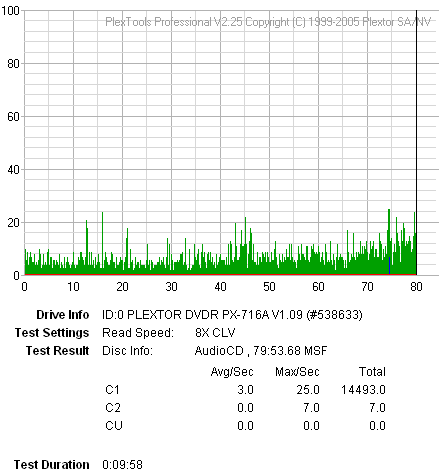
TY 80min 48X @ 40X
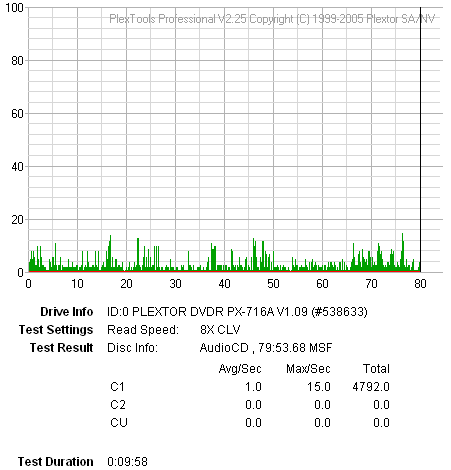
Media Label |
Manufacturer Name |
Lead Out TIme |
BenQ 52X |
Ritek |
79m59s70f |
| Intenso 52X |
Prodisc |
79m59s71f |
| MMore 52X |
Moser Baer India |
79m59s74f |
Traxdata 52X |
Ritek |
79m59s70f |
TY 80min 48X |
Taiyo Yuden |
79m59s72f |
- Summary
Reported CD writing quality is very good according to Plextools Pro Quality scans. In two out of five cases, no C2 errors were reported, while with the other three media (Intenso, BenQ and Traxdata), some C2 were reported, though with very low values.
8. CD Writing Quality - Clover System
Untitled Document
The Clover System CDX Compact Disc Analyzer is a high-speed tool to quantitatively measure the quality of a CD. It will analyze CD-DA, CD-ROM, CD-ROM XA, CD-I, CD-R, Photo-CD, Enhanced CD and CD-RW discs at 4X, 8X, 24X, 32X or 40X speeds. It effectively measures disc quality by examining the quantity and severity of CIRC errors generated during playback. It also provides the capability to measure signal parameters related to pit geometry, such as asymmetry and reflectivity. When put together, all these facts provide a thorough analysis of disc quality. The Clover System Analyzers can also perform various format-checking tests on data discs, and do bit-for-bit data comparison on all types of CDs. All tests are carried out at a maximum speed of 40X.
CIRC error correction uses two principles to detect and correct errors. The first is redundancy (extra information is added, which gives an extra chance to read the disc), and the second is interleaving (data is distributed over a relatively large physical area). The CIRC error correction used in CD players uses two stages of error correction, the well known C1 and C2, with de-interleaving of the data between the stages.
The error type E11 means one bad symbol was corrected in the C1 stage. E21means two bad symbols were corrected in the C1 stage. E31 means that there were three or more bad symbols at the C1 stage. This block is uncorrectable at the C1 stage, and is passed to the C2 stage. Respectively, E12 means one bad symbol was corrected in the C2 stage and E22 means two bad symbols were corrected in the C2 stage. E32 means that there were three or more bad symbols in one block at the C2 stage, and therefore this error is not correctable.
BLER (Block Error Rate) is defined as the number of data blocks per second that contain detectable errors, at the input of the C1 decoder. Since this is the most general measurement of the quality of a disc, you will find BLER graphs for all media tested below. If you click on the images you can see a more detailed table, indicating error levels. The Red Book specification (IEC 908) calls for a maximum BLER of 220 per second averaged over ten seconds. Discs with higher BLER are likely to produce uncorrectable errors. Al low BLER shows that the system as a whole is performing well, and the pit geometry is good. However, BLER only tells us how many errors were generated per second, and it does not tell us anything about the severity of those errors.
BenQ 80min 52X @ 40X
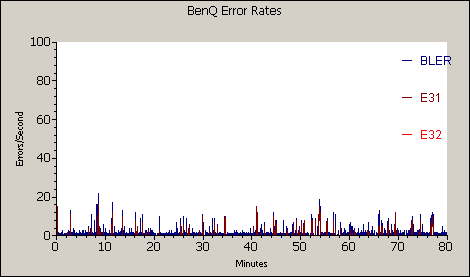
Intenso 80min 52X @ 40X

MMore 80min 52X @ 40X
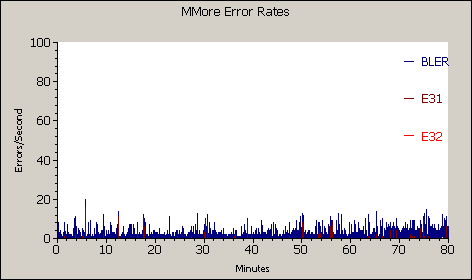
Traxdata 80min 52X @ 40X
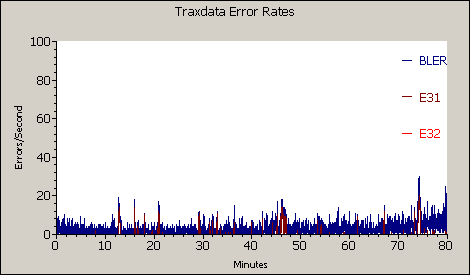
TY 80min 52X @ 40X

- Summary
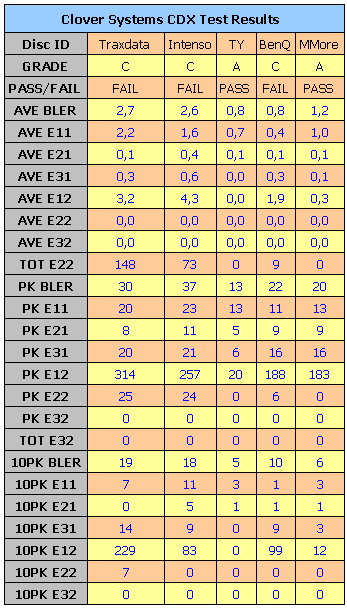
After scanning the CD media used in our tests with the Clover Systems CDX system, we found that media that had reported C2 errors with the Plextools scans, did not qualify as good quality media with the CDX system. Even though these media can be read and don't rank as unreadable, the CDX system has awarded them with a fail mark. It is very good that no E22 or E32 errors were reported. Note here, that the CDX tests, measure the discs using strict criteria and only the best will get a pass mark...
9. DVD Recording Tests
- Writing Performance
Now we will check the burning performance with DVD media. Below, the available writing speed graph can be seen as reported by Nero Burning Rom.

By using Nero CDSpeed with DVD-R and DVD+R media, we are able to see
the 16X writing strategies. WOPC is activated.
- DVD+R media @ 16X CAV

- DVD-R media @ 16X CAV

- Burning Tests
DVD-R media
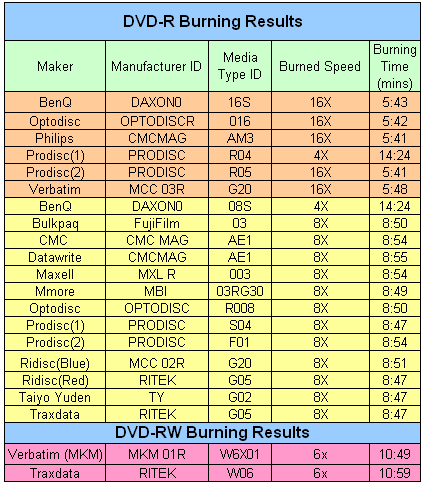
From the media list, almost all media were burned at their indicated speed, with the exception of Prodisc(R04) 16X media burned at 4X and BenQ 8X burned at 4X. Fastest burn came with Philips and Prodisc media, burned in only 5:41mins.

With DVD+R media, the burning time was increased by a few seconds with both 8X and 16X media. Once more, almost all media were burned at their indicated speed while best burn came with Prodisc media, burned in 6:01mins.
- Comparison with other drives


With Write once media, the reported writing times are not that different between all three drives, with the HP being a bit faster when using DVD-R media. With Re-writable media, the HP840b was slowest due to the 4X max writing speed with the 8X MKM +RW media.
- DVD Overburning Tests

The drive does not support overburning with either of the DVD+R or DVD-R formats, producing the above message.
- DVD-RAM
Being a Super Multi drive, the HP 840b supports up to 5X DVD-RAM reading and burning speed.
As Maxell stated: "DVD-RAM is an advanced recording media format that offers a range of digital data applications. Its phase-change recording material allows discs to be re-recordable and erasable, and a superior defect management system ensures accurate recording and playback. DVD-RAM allows instant, random access to any location on the disc for fast and easy data reading and writing. Because DVD-RAM supports fast formatting and no finalizing, it is an extremely easy-to-use media. And with DVD-RAM, changes can be made directly on the disc without the need to transfer data to a hard drive first, speeding up the editing tasks..."
- Burning Tests
Using NeroCDSpeed, we got the following graph:
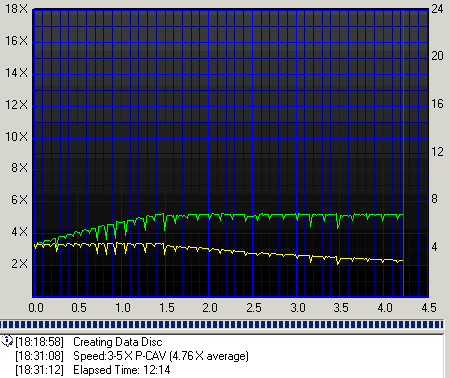
The test started off at 3.23X burning speed and reached 5.09X max, reporting an average speed of 4.76. It took only 12:14mins to complete a full DVD-RAM writing session. The time is with the "Write and Verify" strategy turned off.
Using the latest Nero version, we burned our usual Single Layer DVD compilation.

The writing procedure ended after 29:23mins. The Write and Verify function is in use, hence the increased writing time.
10. DVD Writing Quality - Page 1
In order to test the writing quality and readability of the burned media, we
used two readers equipped with two software applications:
- The LiteON SOHD-167T with patched firmware being able to read DVD5 up to
16X CAV and DVD9 up to 10X CAV. For the transfer rate tests we used
the
latest Nero CDSpeed version.
- The Plextor PX-716A with the latest available firmware. For scanning the
disc, we used the latest PlexTools version at 2X CLV reading speed,
BURST mode, with middle accuracy.
In general, a "perfect" disc should have a smooth reading curve,
very low PIE/POE and zero (0) POF error rates. Most times however, even though
a disc has very low PIE/POE error rates, the reading curve may not be smooth
containing
dropoffs.
Due to the fact that we oversped the reading capabilities of the LiteON SOHD-167T,
such drops are expected, especially near the outer area of the disc.
The measurements below should not be taken as the absolute criterion of the
burning quality, but as an indication level.
16X DVD+R Writing Speed
- BenQ 16X DVD+R @ 16X


- CMC 16X DVD+R @ 16X


- MMore 16X DVD+R @ 16X


- Optodisc 16X DVD+R @ 16X


- Philips 16X DVD+R @ 4X


- Prodisc(1) 16X DVD+R @ 16X
+R_16X.png)
_16X.png)
- Prodisc(2) 16X DVD+R @ 4X
+R_16X_4X.png)
_16X.png)
- Ricoh 16X DVD+R @ 16X


- Ridisc 16X DVD+R @ 16X


- Verbatim 16X DVD+R @ 16X


- Summary
According to CD-Speed and Plextools Pro Quality checks, the overall reported quality of the burned media is good, with the exception of some specific media which reported average to good quality burns.
11. DVD Writing Quality - Page 2
In order to test the writing quality and readability of the burned media we
used two readers equipped with two software applications:
- The LiteON SOHD-167T with patched firmware being able to read DVD5 up to
16X CAV and DVD9 up to 10X CAV. For the transfer rate tests we used the latest
Nero CDSpeed version.
- The Plextor PX-716A with the latest available firmware. For scanning the
disc, we used the latest PlexTools version at 2X CLV reading speed, BURST
mode, with middle accuracy.
In general, a "perfect" disc should have a smooth reading curve,
very low PIE/POE and zero (0) POF error rates. Most times however, even though
a disc has very low PIE/POE error rates, the reading curve may not be smooth
containing dropoffs. Due to the fact that we oversped the reading capabilities
of the LiteON SOHD-167T, such drops are expected, especially near the outer
area of the disc.
The measurements below should not be taken as the absolute criterion of the
burning quality, but as an indication level.
8X DVD+R Writing Speed
- BenQ 8X DVD+R @ 4X


- CMC Magnetics 8X DVD+R @ 8X


- Datawrite 8X DVD+R @ 8X


- Maxell 8X DVD+R @ 8X


- MMore 8X DVD+R @ 8X


- Optodisc 8X DVD+R @ 8X


- Prodisc 8X DVD+R @ 8X


- Ricoh 8X DVD+R @ 8X


- Traxdata 8X DVD+R @ 8X


- TY 8X DVD+R @ 8X


- Summary
According to the graphs, it seems that the drive's writing quality is good in most cases but still needs improvement with specific media such as BenQ and CMC Magnetics.
12. DVD Writing Quality - Page 3
In order to test the writing quality and readability of the burned media we
used two readers equipped with two software applications:
- The LiteON SOHD-167T with patched firmware being able to read DVD5 up to
16X CAV and DVD9 up to 10X CAV. For the transfer rate tests we used the latest
Nero CDSpeed version.
- The Plextor PX-716A with the latest available firmware. For scanning the
disc, we used the latest PlexTools version at 2X CLV reading speed, BURST
mode, with middle accuracy.
In general, a "perfect" disc should have a smooth reading curve,
very low PIE/POE and zero (0) POF error rates. Most times however, even though
a disc has very low PIE/POE error rates, the reading curve may not be smooth
containing dropoffs. Due to the fact that we oversped the reading capabilities
of the LiteON SOHD-167T, such drops are expected, especially near the outer
area of the disc.
The measurements below should not be taken as the absolute criterion of the
burning quality, but as an indication level.
16X DVD-R Writing Speed
- BenQ 16X DVD-R @ 16X

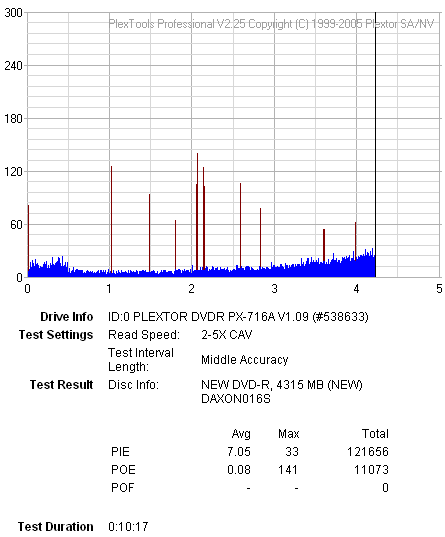
- Optodisc 16X DVD-R @ 16X
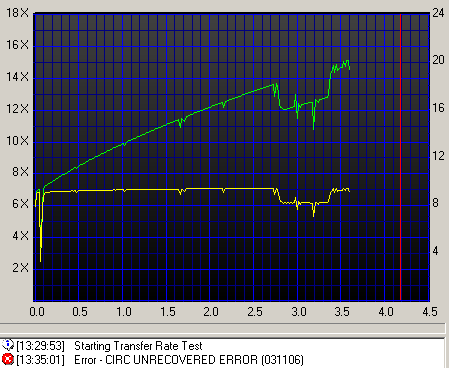

- Philips 16X DVD-R @ 16X
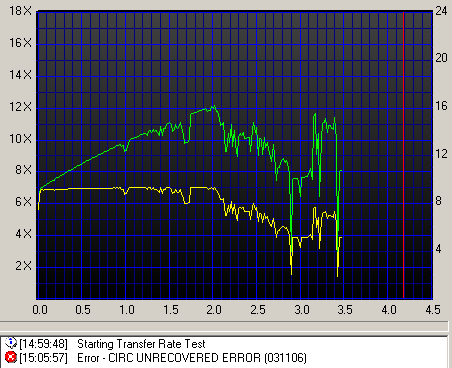

- Prodisc(1) 16X DVD-R @ 4X
-R_16X_4X.png)
-R_16X_4X.png)
- Prodisc(2) 16X DVD-R @ 16X
-R_16X.png)
-16X.png)
- Verbatim 16X DVD-R @ 16X
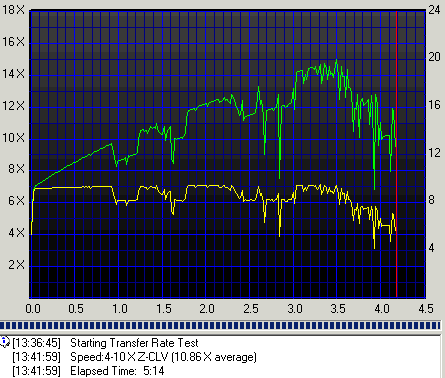

- Summary
This time, the drive reported average writing quality when burning at 16X with DVD-R. The quality levels range from mostly average up to good in some cases, while Optodisc media could not be read by the LiteOn drive and CDSpeed.
13. DVD Writing Quality - Page 4
In order to test the writing quality and readability of the burned media we
used two readers equipped with two software applications:
- The LiteON SOHD-167T with patched firmware being able to read DVD5 up to
16X CAV and DVD9 up to 10X CAV. For the transfer rate tests we used the latest
Nero CDSpeed version.
- The Plextor PX-716A with the latest available firmware. For scanning the
disc, we used the latest PlexTools version at 2X CLV reading speed, BURST
mode, with middle accuracy.
In general, a "perfect" disc should have a smooth reading curve,
very low PIE/POE and zero (0) POF error rates. Most times however, even though
a disc has very low PIE/POE error rates, the reading curve may not be smooth
containing dropoffs. Due to the fact that we oversped the reading capabilities
of the LiteON SOHD-167T, such drops are expected, especially near the outer
area of the disc.
The measurements below should not be taken as the absolute criterion of the
burning quality, but as an indication level.
8X DVD-R Writing Speed
- BenQ 8X DVD-R @ 4X
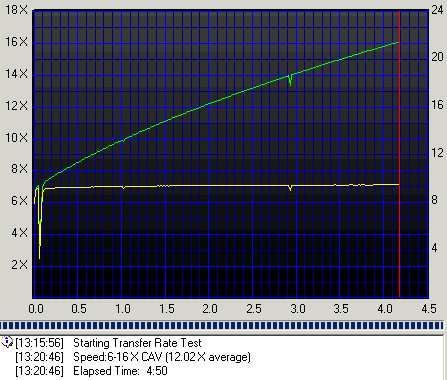

- Bulkpaq 8X DVD-R @ 8X

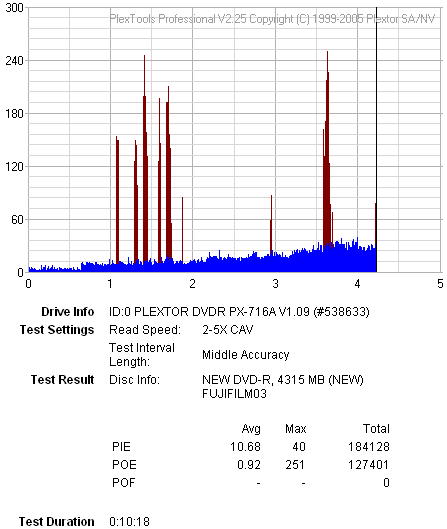
- CMC 8X DVD-R @ 8X
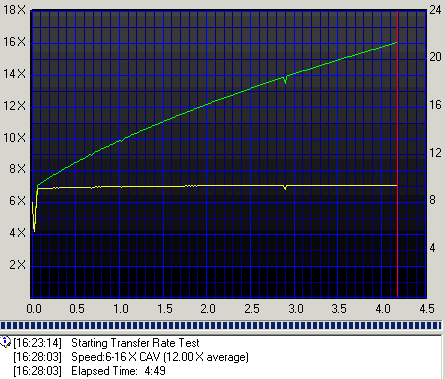

- Datawrite 8X DVD-R @ 8X
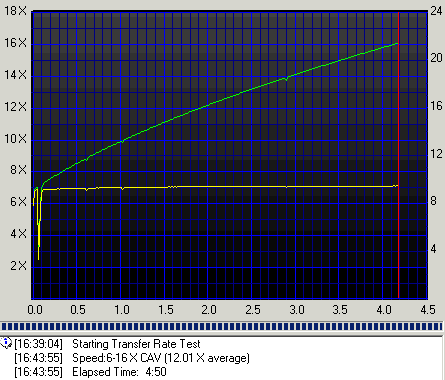

- Maxell 8X DVD-R @ 8X
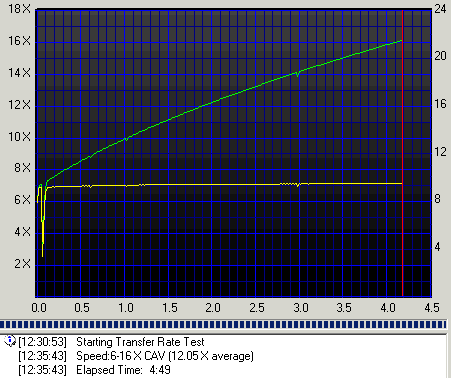

- MMore 8X DVD-R @ 8X
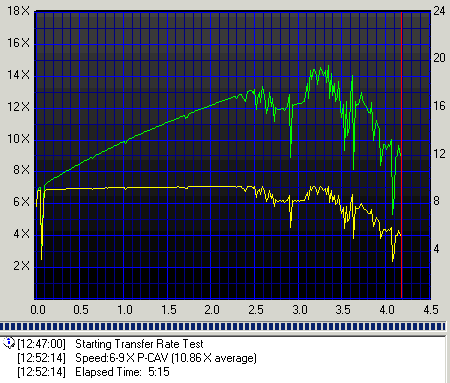

- Optodisc 8X DVD-R @ 8X
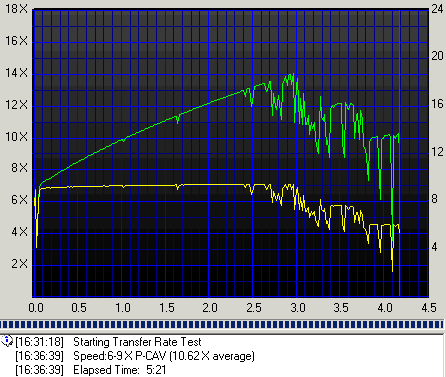

- Prodisc(1) 8X DVD-R @ 8X
_8X.png)
-R_8X.png)
- Prodisc(2) 8X DVD-R @ 8X
_8X.png)
-R_8X.png)
- Ridisc Red 8X DVD-R @ 8X
-R_8X.png)
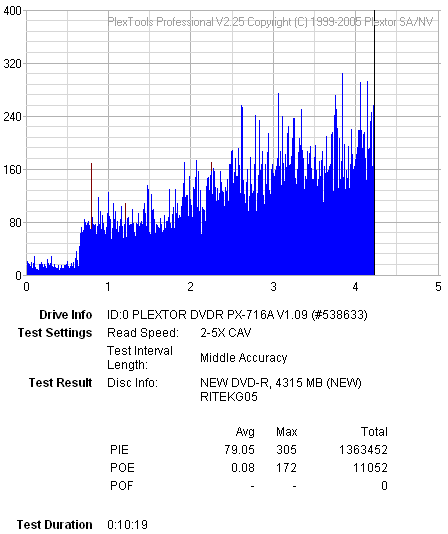
- Ridisc Blue 8X DVD-R @ 8X
-R_8X.png)
-R_8X.png)
- Traxdata 8X DVD-R @ 8X
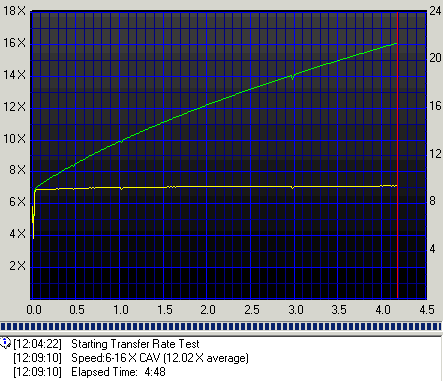

- TY 8X DVD-R @ 8X
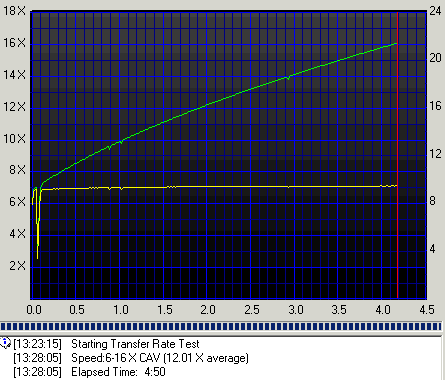

- Summary
As you may have noticed, half of the media reported very good writing quality while the rest, just average. A new firmware might improve things.
14. DVD Writing Quality - Page 5
In order to test the writing quality and readability of the burned media we
used two readers equipped with two software applications:
- The LiteON SOHD-167T with patched firmware being able to read DVD5 up to
16X CAV and DVD9 up to 10X CAV. For the transfer rate tests we used the latest
Nero CDSpeed version.
- The Plextor PX-712A with the latest available firmware. For scanning the
disc, we used the latest PlexTools version at 2X CLV reading speed, BURST
mode, with middle accuracy.
In general, a "perfect" disc should have a smooth reading curve,
very low PIE/POE and zero (0) POF error rates. Most times however, even though
a disc has very low PIE/POE error rates, the reading curve may not be smooth
containing dropoffs. Due to the fact that we oversped the reading capabilities
of the LiteON SOHD-167T, such drops are expected, especially near the outer
area of the disc.
The measurements below should not be taken as the absolute criterion of the
burning quality, but as an indication level.
DVD+RW and DVD-RW Media
- MKM 8X DVD+RW @ 4X


- MKM 6X DVD-RW @ 6X

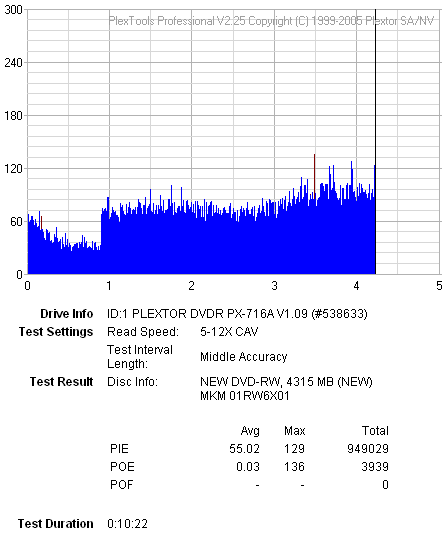
- Traxdata 6X DVD-RW @ 6X
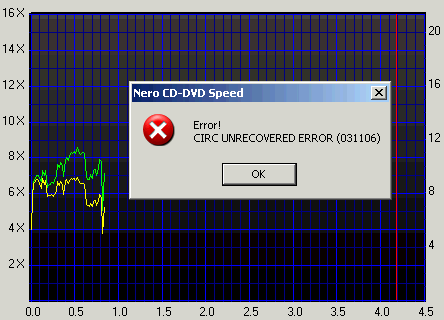

- Summary
Unfortunately, only MKM 6X DVD-RW media burned at 6X, was able to complete both the CD-Speed and Plextools quality tests. Overall, poor DVD RW quality, although a future firmware upgrade may solve this.
15. DVD Writing Quality - Almedio
The AEC-1000 consists of a DVD Drive and the "ALChecker" error measurement application which can check the written data quality. The application is capable of 1X CLV measurement as well as 4X CLV on DVD-Video/ROM and finalized DVD+R/-R media.
There are three measurement modes:
- Fine Mode: checks a series of eight consecutive ECC blocks,
- Rough Mode: checks eight consecutive ECC blocks every 100h ECC blocks
- Quick Mode: checks three specified areas
The checking status is shown graphically in real time while you can save the error graph at the end of the test. The reported errors are the PI and the UncPO. The PI counts the number of rows corrected by the PI error correction in each group of eight consecutive ECC blocks. The UncPO counts the number of ECC blocks in which more than one bytes are uncorrectable in eight consecutive ECC blocks. For our quality scans, we set for 1X CLV and Fine Mode which is the slowest and produces the safest results. Also, we chose to measure all the media burned at the maximum available writing speed, namely 16X.
- BenQ 16X DVD+R @ 16X

- Prodisc(2) 16X DVD-R @ 16X
-R_16X_G.png)
- Ridisc 16X DVD+R @ 16X

- Verbatim 16X DVD+R @ 16X

- Verbatim 16X DVD-R @ 16X
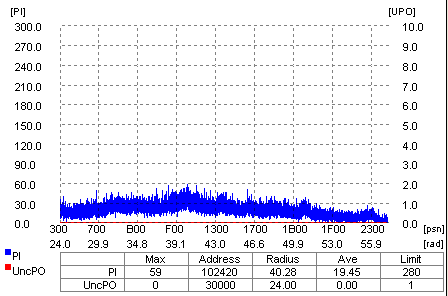
- Optodisc 16X DVD+R @ 16X

- Summary
According to the Almedio AEC-1000 error checker, five out of six media tested were of good quality, and Optodisc was the only media that reported bad burn quality with an Uncorrectable PO.
16. DVD+R DL - Page 1
- Writing Tests
We burned some DVD+R DL and DVD-R DL discs with data content. For this task we used "Create Data Disc" from Nero CDSpeed in order to burn the discs.
Mitsubishi Chemicals DVD+R DL 8X

According to CDSpeed, with Z-CLV strategy, the test started at 4.03X and maxed out at 8.06X, reporting an average speed of 5.68X. The test was completed in 21:15 mins. Note here, that the writing speed dropped before the layer change, and shot back up at the start of the second layer, greatly affecting the burning time. This is somewhat a confusing writing strategy...
Traxdata DVD+R DL 2.4X

While using Traxdata DVD+R DL 2.4X certified media, the drive retained the same speed all the way to the end, reporting an average speed of 2.39X and finishing at a speed of 2.42X with CLV writing strategy.
Mitsubishi Chemicals DVD-R DL 4X

No overspeeding here, where the MKM -R DL 4X certified media was burned at its designated speed. The test started at 4.03X and retained the same speed all the way to the end of the burn. WOPC enabled and with an average speed of 3.99X, the test was finished in 27:08mins.
Traxdata DVD-R DL 4X
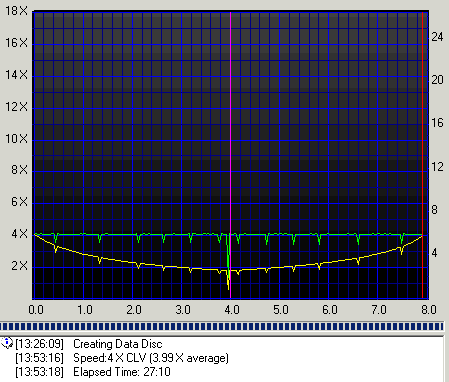
As with the Verbatim media, the HP 840b performed the similarly with the Traxdata -RDL 4X certified media, completing the burn in 27:10mins.
17. DVD+R DL - Page 2
- Writing Quality
In order to test the writing quality and readability of the burned media we used two readers equipped with two software applications:
- The LiteON SOHD-167T with patched firmware being able to read DVD5 up to 16X CAV and DVD9 up to 10X CAV. For the transfer rate tests we used the latest Nero CDSpeed version.
- The Plextor PX-716A with the latest available firmware. For scanning the disc, we used the latest PlexTools version at 2X CLV reading speed, BURST mode, with middle accuracy.
In general, a "perfect" disc should have a smooth reading curve, very low PIE/POE and zero (0) POF error rates. Most times however, even though a disc has very low PIE/POE error rates, the reading curve may not be smooth containing dropoffs. Due to the fact that we oversped the reading capabilities of the LiteON SOHD-167T, such drops are expected, especially near the outer area of the disc.
The measurements below should not be taken as the absolute criterion of the burning quality, but as an indication level.
- Verbatim DVD+R DL 8X @ 8X

Unfortunately the Plextor 716 could not recognize the inserted media.
- MKM DVD-R DL 4X @ 4X
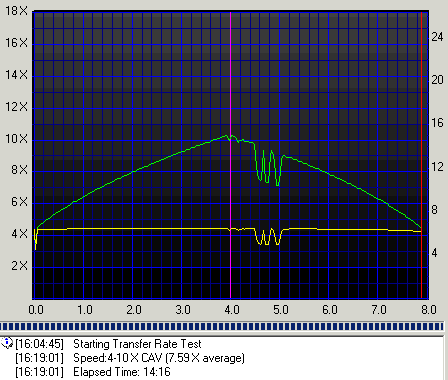

- Traxdata DVD+R DL 2.4X @ 2.4X

Unfortunately the Plextor 716 could not recognize the inserted media.
- Traxdata DVD-R DL 4X @ 4X

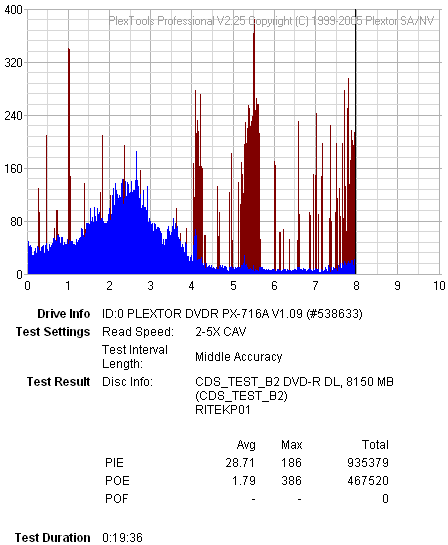
Overall, average quality with the above DL media. We would like to see less errors reported with Plextools in line with results reported with most of the latest burners. In two cases, those of Verbatim DVD+R DL 8X and Traxdata DVD+R DL 2.4X, the Plextor drive could not recognize the media, while the other two media reported high PO values and not so smooth CD-Speed graphs. A firmware release addressing the quality issue here would be welcome.
18. BookType Setting
As in almost all latest release drives, we expected to see the Booktype setting feature supported by the HP 840b. Unfortunately, this is not the case. We tried several of the most popular utilities that offer this function but we failed to change the booktype setting. We couldn't even access the menus most of the time, with "device does not support this feature" popping up. We post some Screenshots taken with the software warning messages...
- DVDInfo Pro

- KProbe

- CD-DVD Speed

19. LightScribe Feature
 As mentioned earlier in this review, the HP 840b, among other things, also features the LightScribe technology. Even though the technology itself has become wide-spread and well known since its release approximately one year ago, never the less, we offer a brief run down of the basics of LightScribe before moving on to the drive's capabilities and performance regarding this feature.
As mentioned earlier in this review, the HP 840b, among other things, also features the LightScribe technology. Even though the technology itself has become wide-spread and well known since its release approximately one year ago, never the less, we offer a brief run down of the basics of LightScribe before moving on to the drive's capabilities and performance regarding this feature.
-What is LightScribe?
With a view to replacing the "old" fashioned CD markers, the LightScribe technology is an integrated system that with the combination of three key elements, manages to produce "precise" as it is said, CD and DVD labels. These three elements are the Lightscribe enabled drive, the specially dye coated discs, and the specific supported software. Note, that the use of specific coated media is required and cannot be done with any ordinary printable media.
-How it works?
In layman's terms, the LS enabled drive, uses a laser that emits light energy onto the thin dye coating of the disc (the label side of the media) chemically changing it so that visible points appear on the disc. As the disc spins inside the drive, the light beam marks even more points on the dye, following the pattern given to the drives mechanism by the LS software mentioned previously. The result is a a precision image on the label side of the disc.
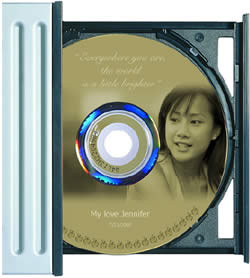
- HP 840b LightScribe Drive
 The process is quite easy, accomplished with the aid of a wizard that is inter grated into the latest Nero releases, as well as in the bundled NERO OEM suite included in the retail package.
The process is quite easy, accomplished with the aid of a wizard that is inter grated into the latest Nero releases, as well as in the bundled NERO OEM suite included in the retail package.
As soon as you press the LightScribe button, located on the top right in the Nero Burning ROM main screen, the wizard prompts you to select the image you want to "print" on the disc media. You can scale the image, use fonts, etc, common tools found with all CD labeling software. You then choose the preferred print quality (print time is dependent on the quality level, which ranges from draft to best) and you are ready to print. The package also contains the SureThing labeling software which will work flawlessly with the drive and labeling process.
Note that in order to print on the LS enabled media, you must put it in the tray upside down. This may seem a bit awkward, but that's the way it must be done.

Last step, we start printing the media. The Printing process depends on the print quality selected and differs from drive to drive.

Our tests confirmed the quality - time ratio given by the manufacturer. For a best quality print, the time required was approx. 28mins.

The results of this test were quite good...

That's about it for the LightScribe capabilities of the HP 840b. Now let's move on to the last page and the conclusion of the HP840B review.
20. Conclusion
 Several months ago, we were introduced to the LightScribe feature, with the release of three drives, the HP640i, the Philips DVDR16LS and the BenQ DW1625, all of them offering the new LightScribe feature. The HP840i (or 840b as it was recognized under windows XP) is actually an upgrade of the 640i, with regard to writing speeds and Multi-media support. The main difference between the former LS HP drive and the latest release, is the use of an entirely different chipset. Where the 640i used the Nexperia PNX7860E, the 840i now uses a Panasonic chipset.
Several months ago, we were introduced to the LightScribe feature, with the release of three drives, the HP640i, the Philips DVDR16LS and the BenQ DW1625, all of them offering the new LightScribe feature. The HP840i (or 840b as it was recognized under windows XP) is actually an upgrade of the 640i, with regard to writing speeds and Multi-media support. The main difference between the former LS HP drive and the latest release, is the use of an entirely different chipset. Where the 640i used the Nexperia PNX7860E, the 840i now uses a Panasonic chipset.
The new 840b drive is an average reader with CD media. It can read up to 40X speed all CD-R discs and up to 32X, USRW media. DVD reading speeds are satisfactory, with the drive being able to read up to 16X pressed SL media and 8X pressed DL media. DVD-RAM is also supported and the HP840b can read DVD-RAM media at a max speed of 5X. For ripping enthusiasts, the HP840b will not disappoint you, and the ripping speeds achieved can be described as average to good.
In the Error Correction area, the HP840b is fairly good, as it managed to achieve good results with both CD and DVD media formats. The drive achieved a good score with the 721 CD test media, while it managed to achieve flawless reading with the 726 test disc and successfully played back 4 of 5 tracks on the CD-Audio check disc. Very good performance and indication of good error correction with CD media. With DVD media, the drive did not report any errors while reading all our defects test media.
Protected discs posed a problem for the review drive, as it did not manage to rip Sony's Key2Audio protected media. Both other audio protected titles were ripped successfully however. Protected games ripping was successfully completed with the drive showing good capabilities and being able to back up SD v3.1.
Moving on to the writing capabilities, the drive managed to produce some good quality burns with the CD media inserted, even though none of them was actually burned at 48X, the max supported writing speed according to the manufacturer's specs. When it comes to DVD media writing capabilities, the HP840b is an average burner, with the quality very much dependent on the inserted media. Best quality burns came at 8X burning speed, while the drive seems to favor +R media. DVD Rewritable as well as DL media writing quality was not satisfactory and hopefully a future upgrade in the firmware might solve issues with certain media.
DVD-RAM writing is also supported at a maximum burning speed of 5X. Note here, that when burning with Nero, the reported completion time exceeded the normal time needed for a complete burn, due to the write and verify function used with DVD-RAM media.
LightScribe capabilities of the drive are as expected with no changes in the procedure or the quality of the produced LightScribe media. With "best" quality level, the drive can complete a "print" on the LS media in 28 mins. The process is easy enough, with a wizard to guide you through. For en extra touch, the bundled SureThing labeling software will do the trick.
- The Good
- Good DVD error correction capabilities
- 5X DVD-RAM read/write support
- Writing quality with most media
- LightScribe enabled drive
- Good score in CD-Audio Check disc test
- Can overburn CD media up to 99mins
- Can create working backups with SafeDisc protected games v3.1
- Good retail package
- The Bad
- Performance with 90min Audio CD
- Cannot overburn DVD recordable media
- DL and RW quality with certain media
- BookType Setting is not supported
- Like To be fixed
- Writing quality with specific media
| Retail Package |
 |
| Reading |
 |
| Error Correction |
 |
| Protected Discs |
 |
| Writing |
 |
| Features |
 |